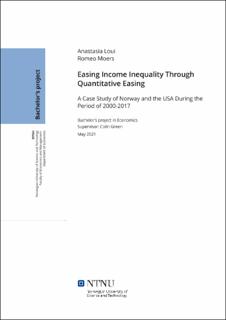| dc.contributor.advisor | Green, Colin | |
| dc.contributor.author | Loui, Anastasia | |
| dc.contributor.author | Moers, Romeo | |
| dc.date.accessioned | 2021-09-14T17:12:58Z | |
| dc.date.available | 2021-09-14T17:12:58Z | |
| dc.date.issued | 2021 | |
| dc.identifier | no.ntnu:inspera:81689313:82170505 | |
| dc.identifier.uri | https://hdl.handle.net/11250/2777084 | |
| dc.description.abstract | Denne bacheloroppgaven analyserer de potensielle effektene Kvantitativ lettelse (QE) kan ha på inntektsulikhet. En økning i pengemengden (M1) brukes som en representasjon av QE og Gini-koeffisienten brukes som måling for inntektsulikhet. Denne undersøkelsen gjøres gjennom en Multiple Linear Regression (MLR) -modell ved bruk av metoden Ordinary Least Squares. Data for hver variabel som inngår i denne analysen er fra årene 2000-2017, både for Norge og USA.
Når vi gjennomfører hypotesetesten for å se om det er noen statistisk signifikant effekt av en økning i pengemasse på Gini-koeffisienten i Norge, avviser vi ikke nullhypotesen. Når vi gjennomfører den samme hypotesetesten for USA, ved hjelp av oppgitte data, er vi i stand til å avvise nullhypotesen. Forskjellen i resultater kan potensielt skyldes store forskjeller i skattesystemer og initielle forskjeller i inntektsulikhet, men denne påstanden krever ytterligere undersøkelse. | |
| dc.description.abstract | This paper focuses on analysing the potential effects Quantitative Easing (QE) may have on income inequality. An increase in money supply (m1) is used as a representation of QE and the Gini coefficient is used as the measurement for income inequality. This investigation is done through a Multiple Linear Regression (MLR) model using the Ordinary Least Squares method. The data for every variable included in this analysis is from the years 2000-2017, for both Norway and the USA.
When conducting the hypothesis test to see whether there is any statistically significant effect from an increase in money mass on the Gini coefficient in Norway, we fail to reject the null hypothesis. When conducting the same hypothesis test for the USA, using the data provided, we are able to reject the null hypothesis. The difference in results may potentially be due to large differences in taxation systems and initial differences in income inequality, however, this claim requires further study. | |
| dc.language | eng | |
| dc.publisher | NTNU | |
| dc.title | Easing Income Inequality Through Quantitative Easing | |
| dc.type | Bachelor thesis | |
